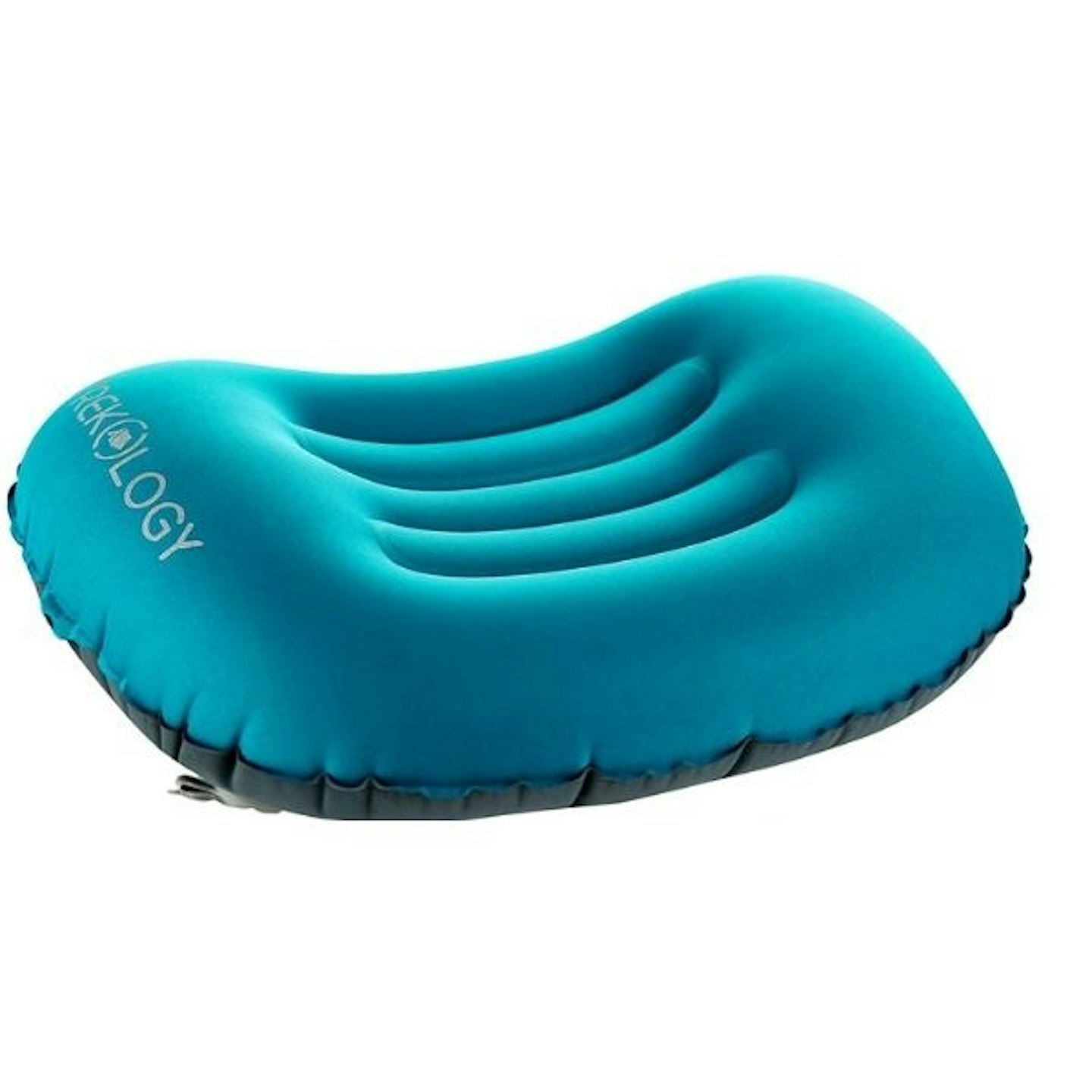Never underestimate what a good night's sleep can do for you. When you're camping or backpacking, you need some quality sleep to make the most of the following day – and it all starts with a good camping pillow.
Of course, when you're trekking, you'll want to maximise as much space in your backpacking rucksack as you possibly can, so a bulky pillow is not a good use of space.
However, like many other camping gadgets and accessories, the current range of cleverly engineered camping pillows have managed to shrink drastically while maintaining comfort.
Camping pillows are specifically made to be compact yet provide good support to ensure you get proper rest. This really pays dividends if you're camping for several nights.
The support that a decent pillow and sleeping mat can offer your neck, head and spine will serve to align your body during sleep, and therefore improve your recuperation and give you more energy to tackle the day.

These pillows have come leaps and bounds over the years and are no longer air-tight sacks of stale breath. The new contemporary designs are made with thought and can fold down to the size of a lime (or lemon if that's your citrus of choice) without compromising on comfort.
There are even options that are similar to ‘real’ pillows, with a memory foam filling and comfortable lining, so you don't need to fret about being poorly rested during your trek.
Below, you'll find our current selection of the best camping pillows, plus a guide on what to look for when buying one.
Editor's note: This article was updated on 10 July 2025, when we added eight new reviews into this buying guide and picked our award winners.
Best camping pillows at a glance
Best camping pillow overall: Nemo Fillo Elite Pillow
Best non-inflatable camping pillow: Exped Deepsleep Pillow L
Highly rated: Sea to Summit Aeros Ultralight Pillow Regular
Highly rated: Exped Ultra Pillow M
How we tested the best camping pillows
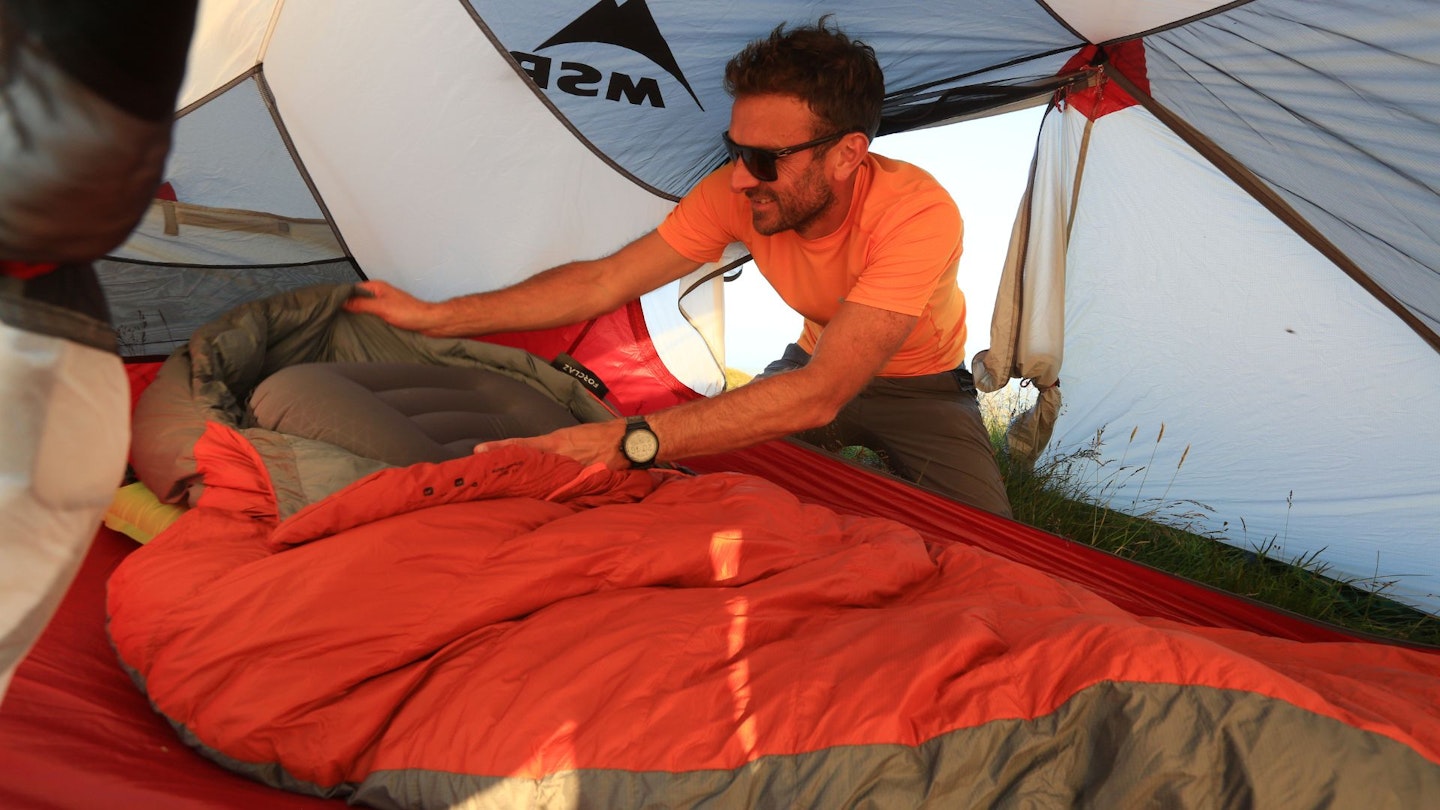
At LFTO, we spend a lot of time in tents and bivvy bags. We sleep on mountaintops, camp out in caves, spend long nights in ramshackle Scottish bothies and occasionally even treat ourselves to the luxury of a campsite with a toilet block.
We camp in all seasons, in all weathers, and don't mind admitting we try to make life as comfortable as possible for ourselves when we do it.
Inflatable camping pillows are things that have slowly started creeping into our backpacks over the last few years and they've been a revelation. They weigh almost nothing, pack down smaller than a Coke can, are simple to inflate and for the most part are very comfortable places to rest your head.
We've tested a few to destruction on some of our wilder camps, but for the most part they've been great additions to our backpacking adventures and overnight camps.
Most of the options included below have been tested by LFTO deputy editor Rob Slade and former senior writer Chris Williams. When testing, we've focused on key criteria, including: comfort, support, weight, pack size and value for money.
Read more about how we test here.
The best camping pillows reviewed:
The Fillo Elite is one of two inflatable camping pillows in this test that come with a fabric cover, yet it still packs down impressively small (comparable with an apple – it’s the third smallest on test). A weight of 70g also puts it third lightest, missing out on second spot to the Sea to Summit Aeros Ultralight by only a gram.
That’s impressive, but so is the comfort on offer. The surface fabric feels soft and comfy against your face, while recycled insulation offers a little extra warmth and padding.
A loft of 8cm (by my measurements) isn’t as high as some but still felt plenty for side sleeping and worked well for sleeping on the back.
When fully inflated to the max the pillow can feel quite firm, but not uncomfortably so, while the ergonomics of the internal bladder help to cradle your head in place. This means that even if you let out a bit of air for a softer feel you don’t end up bouncing about.
The valve used here is unique in this test and isn’t quite as easy to use, as you have to push it in while breathing into it to close it before air escapes. It’s a minor qualm, though, and it’s easy enough to get the hang of after a few tries.
I also love that the stuff sack is built into the pillow cover, which means you’ll never be rummaging around in your tent to try and find it, while the pillow’s outer cover is easily removed for machine washing.
It’s not the widest and with an RRP of £62 it’s certainly not the cheapest, but it’s probably the best camping pillow we’ve tested to date. And if you’re invested in being both lightweight and comfortable on your adventures, this is a winning ticket.
Pros
- Very comfortable outer fabric
- Structure helps cradle your head in place
- Removable, machine washable outer
- Integrated stuff sack
Cons
- It's damn expensive
| RRP: | £62 / $59.95 |
| Type: | Hybrid/insulated inflatable |
| Weight: | 70g |
| Pack size: | 12cm x 7cm x 6.5cm |
| Dimensions: | 34cm x 26cm x 8cm |
The Exped Deepsleep Pillow is one of three non-inflatable pillows featured here and it’s both the lightest (249g) and most packable of the bunch.
That’s still several times bigger than the smallest inflatable one, but it’s probably just about small enough that you could be tempted to take it wild camping for the night.
And it’s a tempting thought. While some of the inflatable options can feel bouncy, you don’t get that here. The cushioning is provided by an upcycled foam chip core, which feels plush and comfy when you lay your head down.
It lofts to around 13cm by my measurements, making it a fine option for side sleeping, though it does compress adequately to make it ideal for back sleeping, too.
You also get a strap on each side, which you can use to tie your pillow onto your sleeping mat if you wanted to.
One thing to note is that right after being compressed the pillow can feel a little uneven, but it does bounce back well if you leave it alone for a few minutes, so be sure to do that before settling down for the night.
Being a slightly more technical pillow, the price does tick up here and you’re faced with an RRP of £36, but as you can probably get away with using this for both car camping and occasional backpacking, I think that’s decent value.
Pros
- Extremely comfortable
- Just about compact enough for some wild camping
- Good loft for side sleeping
- Wider than many others on test here
Cons
- Price is at the higher end
- Heavier and bulkier than inflatable options
| RRP: | £36 / $39.95 |
| Type: | Foam filled |
| Weight: | 249g / 8.8oz |
| Pack size: | 21cm x 16cm x 13cm |
| Dimensions: | 47cm x 26cm x 13cm |
At 69g the Aeros Ultralight Regular is the second lightest camping pillow in this test, but it’s also the smallest when packed down. When it is, it’s no bigger than a satsuma orange.
When blown up, which only takes two breaths, you get 9.5cm of loft, which is plenty for side sleeping. It may feel a little bit high for some back sleepers, but that’s going to be a case of personal preference.
Of course, you can let some air out, which is easy to do in a controlled manner thanks to the fantastic valve system. And the good news is that doing so doesn’t leave you feeling like your head is on a trampoline. Yes, there’s more movement, but not excessively so.
There’s minimal bounce when fully inflated, too, while the contoured design helps keep your head in place. Meanwhile, the face fabric is made from 20D stretch polyester. It feels nice on the face but doesn’t quite match the exceptional comfort of the Nemo Fillo Elite.
Like a couple of the other lightweight options here that don’t have external covers, you’ll want to be careful to avoid punctures, much in the same way that you do with inflatable sleeping mats.
Speaking of which, if you own (or plan to own) a Sea to Summit sleeping mat then you’ll be able to benefit from the brand’s Pillow Lock system. Essentially, Sea to Summit ships self-adhesive hook-and-loop patches with its mats, which can then secure your mat onto the base of your pillow.
It’s a nice idea, but not everyone will be able to make use of it. Luckily, though, this medium-sized pillow will also fit nicely into the hood of most sleeping bags.
There’s not much to fault here. This is a brilliant camping pillow and it offers exceptional value with an RRP of £35 (though quite often you can find it discounted).
Pros
- Incredibly small and lightweight
- Contoured design helps keep head still
- Fantastic valve system helps achieve perfect firmness
Cons
- Not as wide as some others
- Needs to be treated with care so you don't puncture it
| RRP: | £35 / $49.95 |
| Type: | Inflatable |
| Weight: | 69g |
| Pack size: | 9cm x 6cm x 5cm |
| Dimensions: | 35cm x 25cm x 9.5cm |
The Ultra Pillow M looks similar to Sea to Summit’s Aeros in a lot of ways, and the performance is similar, as well.
This is another super lightweight offering. A weight of just 56g makes it the lightest on test, while it’s the second smallest when packed down, which is perfect for backpacking.
Simply put two big breaths into the valve for it to be fully inflated and then you’re left with 9.5cm of loft (the same as the Aeros). Again, it’s decent for side sleepers and is likely to work for most on their back, too.
It’s easy enough to let a bit of air out to fine tune the firmness and height you want from your pillow and, vitally, there’s not loads of head movement once you’ve done so. This is in part thanks to the ergonomics of the pillow, which work well.
By our measurements, this pillow is 1cm wider and 3cm longer than the Aeros Ultralight Regular, but it’s not all that noticeable in real life.
One other thing that differentiates the two is that the latter has less of a bump at the base of the pillow. I found both comfortable, but the Ultra and its lump does provide a bit more neck support.
The outer fabric used here is a 20D recycled stretch polyester, which is comfortable enough without making me go “oooh”.
You do get a loop on each end of the pillow to help you fasten it to your sleeping mat if you want, but most will probably tuck it into or under their sleeping bag hood.
With the same £35 RRP as the Aeros, it’s hard to pick between the two, so I won’t! Both would be an excellent pick for backpacking.
Pros
- Incredibly lightweight and packable
- Excellent support
- Pretty comfy for an inflatable
- Roomy stuff sack
Cons
- Not as comfy as the Nemo
- Care required to avoid punctures
| RRP: | £35 / $39.95 |
| Type: | Inflatable |
| Weight: | 56g |
| Packed size: | 10cm x 5.5cm x 5.5cm |
| Dimensions: | 36cm x 28cm 9.5cm |
The big standout feature of the Rab Stratosphere Pillow has to be the outer cover. It’s soft, comfortable and the top section also incorporates recycled polyester insulation for a nice touch of warmth.
That alone makes it a nice spot to sleep, while a loft of 9cm (by our measurement – Rab quotes 10cm) makes it workable for side sleepers.
It’s not all good, though. The internal airbag is quite crinkly and it can get noisy when you’re fidgeting at night. And while Rab says the outer is removeable for washing, it’s not actually possible due to the valve closure essentially being fed through a small hole in the fabric cover.
I also found it hard at times to find the right firmness, caught between it being too hard or, when some air was let out, resulting in too much head movement. The process of letting out air wasn’t as straightforward as I expected, either, as the outlet was quite rigid and didn’t budge without significant finger force.
If you like a firm pillow, though, you’ll probably have better luck than me. And admittedly, I got on with it better when sleeping on my side.
Weight (112g) and pack size is decent, being similar to the Sierra Designs Gunnison, though the small stuff sack only has an elastic opening rather than a drawcord, which can be awkward to use when packing away.
This is by no means a bad pillow. The material is lovely and it works well for side sleepers or people who like a bit of firmness.
Pros
- Lovely outer material
- Decent pack size
- Good loft and support for side sleeping
Cons
- Tricky to achieve perfect firmness
- Noisy internal air bag
- Not the easiest to squeeze into its stuff sack
| RRP: | £40 / $45 |
| Type: | Insulated inflatable |
| Weight: | 112g / 4oz |
| Pack size: | 12cm x 7cm x 7cm |
| Dimensions: | 38cm 26cm x 9cm |
The Gunnison is the widest inflatable camping pillow in this test, which is handy if you’re the sort of sleeper that rolls around a lot. After all, you don’t want to end up falling off your pillow.
A note of caution, though, as if you do tend to fidget a bit in bed, then you may find this pillow a bit bouncy. This is an issue that’s associated with many inflatable pillows on some level, but it feels a little more pronounced here.
It’s not a big issue, as you’ll hopefully fall into slumber quickly, but if you’re a side sleeper it’s something to keep in mind, as this is when it’s most noticeable.
Being the largest inflatable pillow, it did take the most breaths to blow up, but that only equated to three and a half, which is no effort at all, really.
When fully blown up the pillow is supportive but somewhat firm, and delivers a height of 10cm, which works well for support when sleeping on your side.
If you want less loft, you can open the valve and push the tab slightly to let some air escape.
The surface is made of polyester, which is fine to sleep on, but it doesn’t feel as nice as a softer material.
On the underside of the pillow you’ll spot large silicone detailing, which is designed to grip onto your sleeping mat so it doesn’t move around a lot. It works okay and is better than nothing. Plus, I think it’s best to use this pillow outside of your sleeping bag hood anyway given its width.
As the widest inflatable option, the Gunnison has the largest pack size of this type on test, but that’s only the size of a large apple, which isn’t going to cause you any concern. Plus, the stuff sack has plenty of spare space, so it’s not a mission to pack it away.
The other bonus is the price – at £30 I’d have to say this is pretty good value compared to some pricier competitors.
Pros
- Nice wide sleeping surface
- Good value for money
- Easy to pack away into stuff sack
Cons
- Can feel rather bouncy
- Surface material doesn't feel the most luxurious
| RRP: | £30 |
| Type: | Inflatable |
| Weight: | 96g / 3.4oz |
| Pack size: | 10cm x 8cm x 7cm |
| Dimensions: | 51cm x 30cm x 10cm |
The Constellation looks and feels very much like the sort of pillow you’d have on your bed at home, though the materials are more heavy duty.
It’s the widest option on test, too, but that does mean that it’s also the heaviest (420g) and least packable. In reality, though, it’s been designed for car camping and was never really intended for backpacking.
Still, it’ll take up more room in your boot than many other options in this test, so does it deliver higher levels of comfort?
I’d say it’s probably among the most comfortable given its similarity to what you’d have at home. Laid out fully I found it a little flat, lofting to just 6.5cm, which is fine for back sleepers, but a little short for side sleepers.
That said, you can fold it over to double the height, which works well, and the pillow even stays folded over when you lift your head off it. The fabric feels nice against your face, too, while the inner cushioning (consisting of recycled polyester) is well spread out.
One issue I do have, though, is that the Constellation has an RRP of £28.99, which is considerably more than a standard pillow. Might it be tempting to just take one from home instead? Yes, but I guess then you don’t get the handy, protective stuff sack…
Pros
- Cosy pillow-like comfort
- Can be folded over for more height
- Lovely outer fabrics
Cons
- Quite a large pack size
- Expensive compared to normal pillows
| RRP: | £28.99 |
| Type: | Filled |
| Weight: | 420g / 14.9oz |
| Pack size: | 38cm x 17cm x 14cm |
| Dimensions: | 55cm x 38cm x 6.5cm |
At a penny under £8 this pillow from Decathlon’s Quechua brand is excellent value. It’s pretty much unbeaten in that respect here, but as a result there are some gaps in performance.
But first, the positives. It’s stuffed with a polyester filling and, along with the Outwell option, is the most pillow-like on test.
It lofts to 11cm, which is 4.5cm more than the Outwell. This makes it a good option for side sleepers that need a little more height, while I also found it fine when sleeping on my back.
One issue I have, though, is that the filling often isn’t evenly distributed, which leaves dense sections alongside less cushioned areas.
It’s also the second largest pillow when packed down into the included stuff sack, which would make me think twice about taking it backpacking (car camping would be fine, though). A weight of 390g also makes it the second heaviest.
Pros
- Exceptional value for money
- Actually feels like a pillow, most of the time
Cons
- Can be lumpy
- Poor weight and pack size
| RRP: | £7.99 |
| Type: | Filled |
| Weight: | 390g |
| Pack size: | 16cm x 14cm x 14cm |
| Dimensions: | 40cm x 24cm x 11cm |
Other camping pillows to consider...
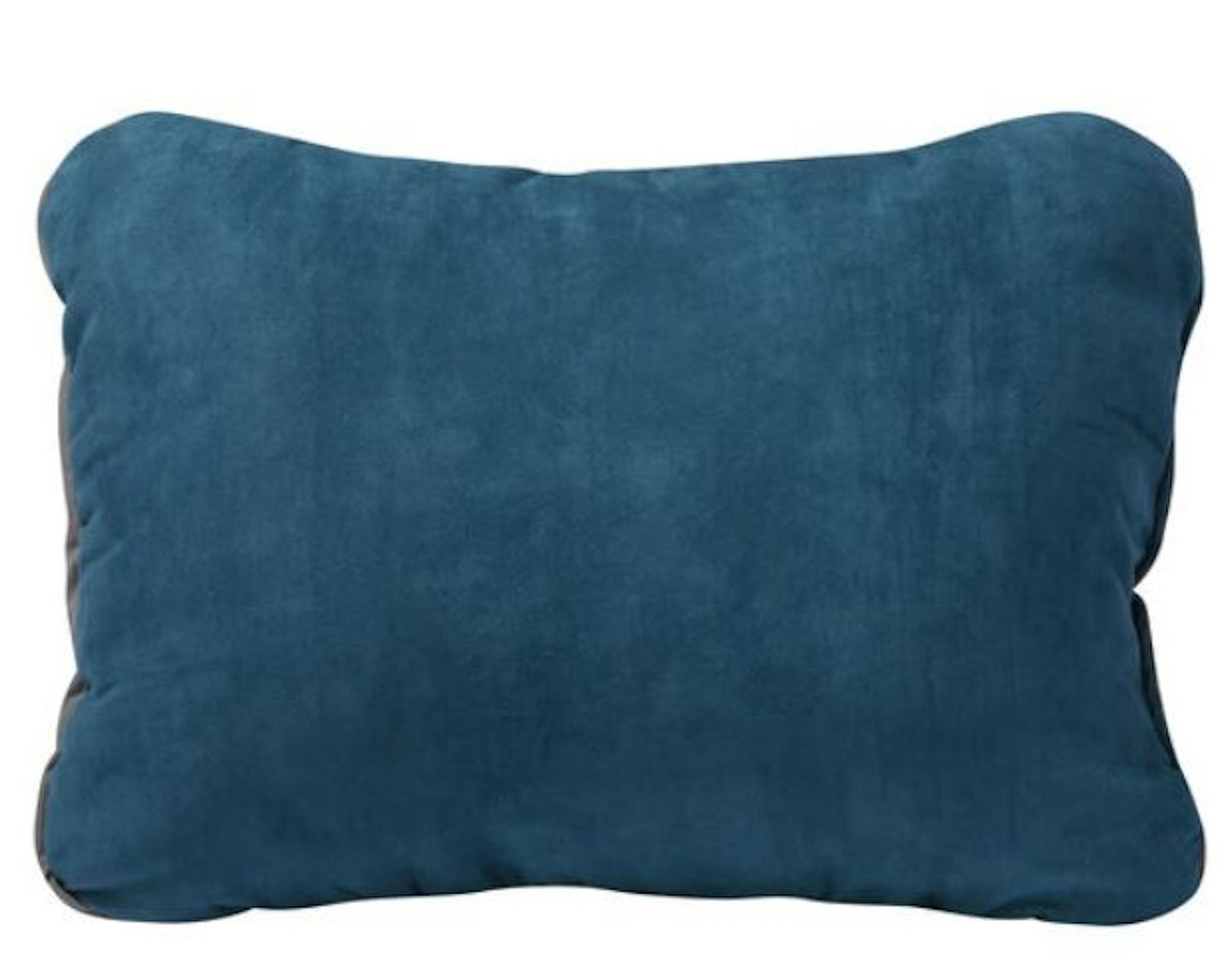
Similar to the Nemo Fillo in principle but at a lower price. The Therm-a-Rest pillow also features an inflatable core paired with insulation and is available in three sizes. The downsides are that it’s heavier and not as compact – the Regular size is about the dimensions of a one-litre bottle when rolled up.
It is made with foam offcuts, up-cycled from the manufacturing process of the equally impressive Therm-a-rest ProLite sleeping mat. The brushed polyester outer is soft and made from 60% recycled materials. If you are looking for a sustainable, supportive option then this would be an excellent choice for you, provided you have the space for it.
Pros
- Sustainable
- Very comfortable
- Three sizes
Cons
- A bit heavy
- Not very compact
| Type | Insulated inflatable |
| Weight | 210g |
| Packed size | Not given |
| Dimensions | 38 x 28 x 13cm |
Trekology won Best Value for our walking pole group test and its camping pillow also gets kudos for representing a great budget buy.
Its pretty lightweight, too, but isn’t quite as comfortable as many others here due to the lack of insulation and inferior fabric.
That said, it’s still a great camping pillow that packs down to the point where it barely robs any space at all.
Pros
- Lightweight
- Many colours available
Cons
- More comfortable options available
| Type | Inflatable |
| Weight | 78g |
| Packed size | 13 x 5cm |
| Dimensions | 40 x 30 x 10cm |
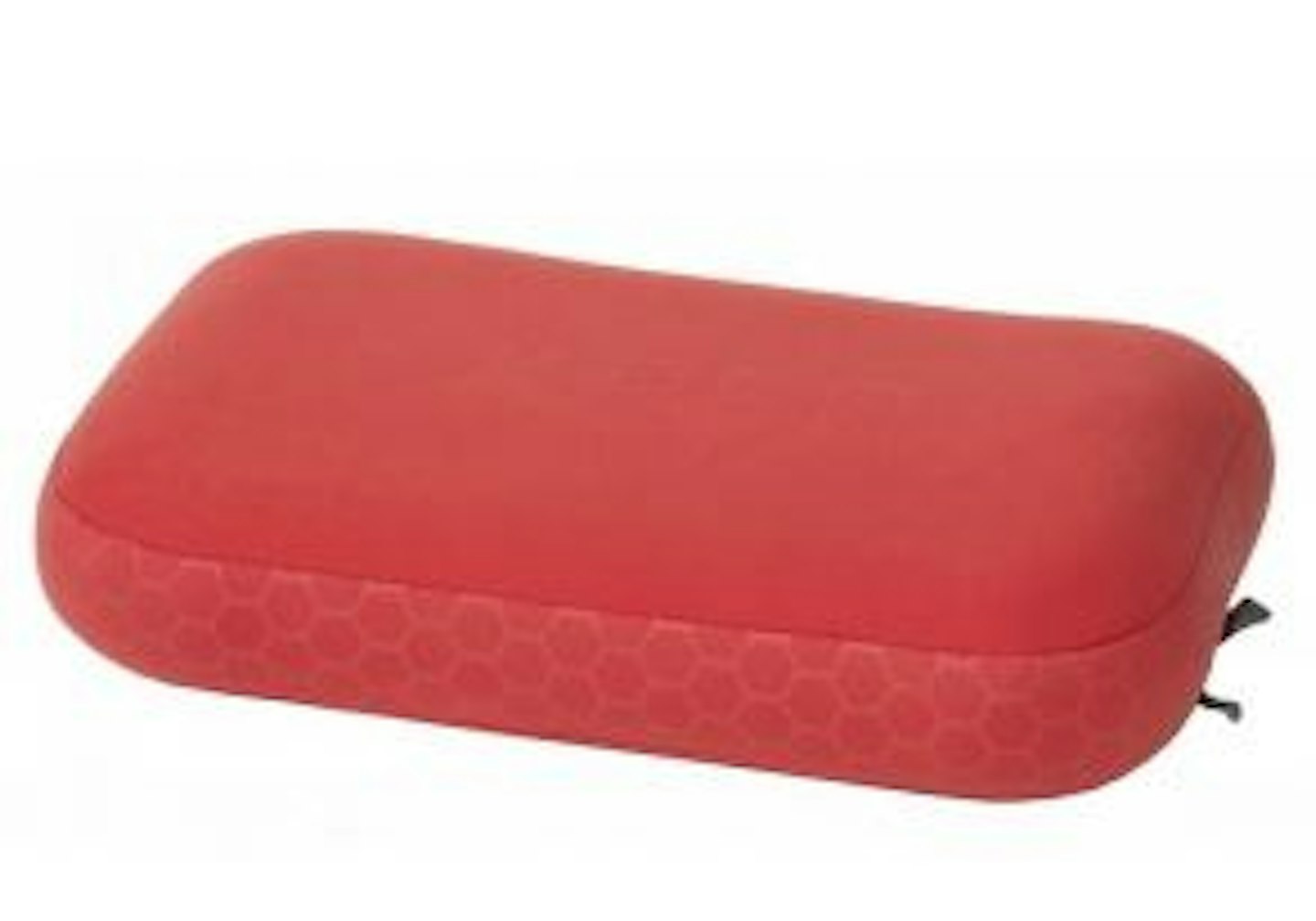
www.outdoorgear.co.uk
One of the most pillow-like pillows you’ll find that remains reasonably compact when packed away is this. While inflatable, it also has fleece padding surrounding the air baffles, which provides a lot of comfort for campers.
Although the MegaPillow sounds chunky, it's still reasonably light. However, there are certainly smaller, lighter options available. If you have the space for it, your body will thank you for it.
Pros
- Among the most comfortable here
- Internal stuff sack
- Regular pillow shape
- Climate neutral product
Cons
- Relatively heavy
| Type | Inflatable |
| Weight | 170g |
| Packed size | 13 x 10cm |
| Dimensions | 53 x 32 x 12cm |
Types of camping pillows
Camping pillows come in many different forms, but they can largely be broken down by the following categories:
Inflatable pillows
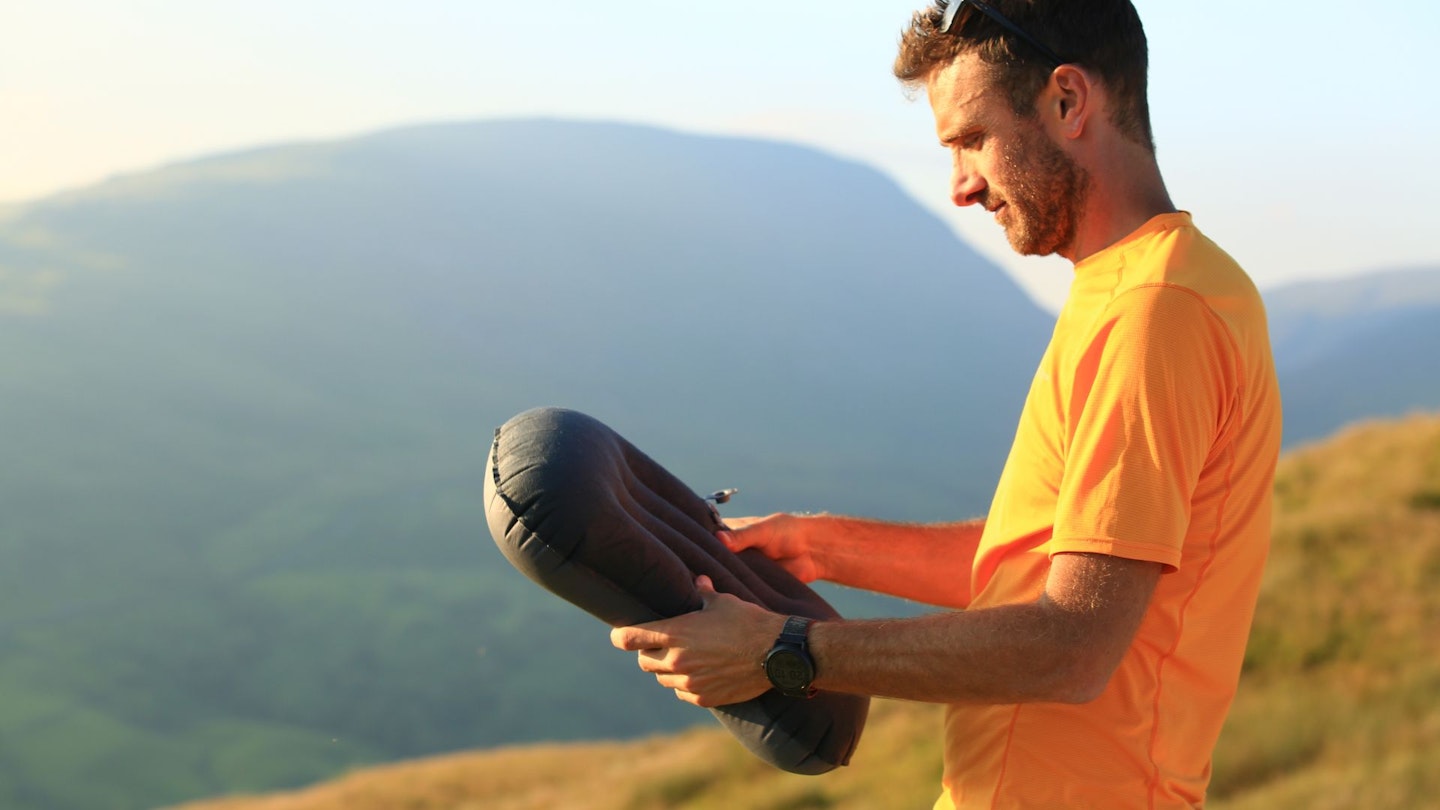
Inflatable pillows are popular among backpackers and multi-day hikers due to their ultralight weight and compact packed size. These pillows typically use an air bladder that you inflate by mouth or with a pump, allowing you to adjust firmness.
While they’ll undoubtedly help you keep the weight down and save space (many pack down to the size of a child’s fist), they can feel bouncy or crinkly compared to traditional pillows, which isn't always particularly welcome.
Another pitfall of this type of pillow is that they sometimes have a tendency to slide around on your sleeping pad if there’s no grippy texture or fabric on the bottom.
Compressible pillows
Compressible camping pillows use foam, down, synthetic fill or a combination. They attempt to mimic the feel of a regular bed pillow for increased comfort and support.
While compressible pillows are generally more comfortable and quieter, they’re often bulkier and heavier than inflatable options.
They can sometimes also feel a bit flat, and may not be ideal if you’re trying to limit the weight of your pack or minimise your pack size. Because of that, they’re perhaps best suited to car camping.
Hybrid pillows
Yes, you can absolutely have the best of both worlds, because hybrid pillows combine an air bladder with an outer layer of foam or insulation.
How successfully this is achieved varies from brand to brand, but generally it does help deliver more loft and comfort while still retaining decent packability and a low weight.
What to look for in a camping pillow
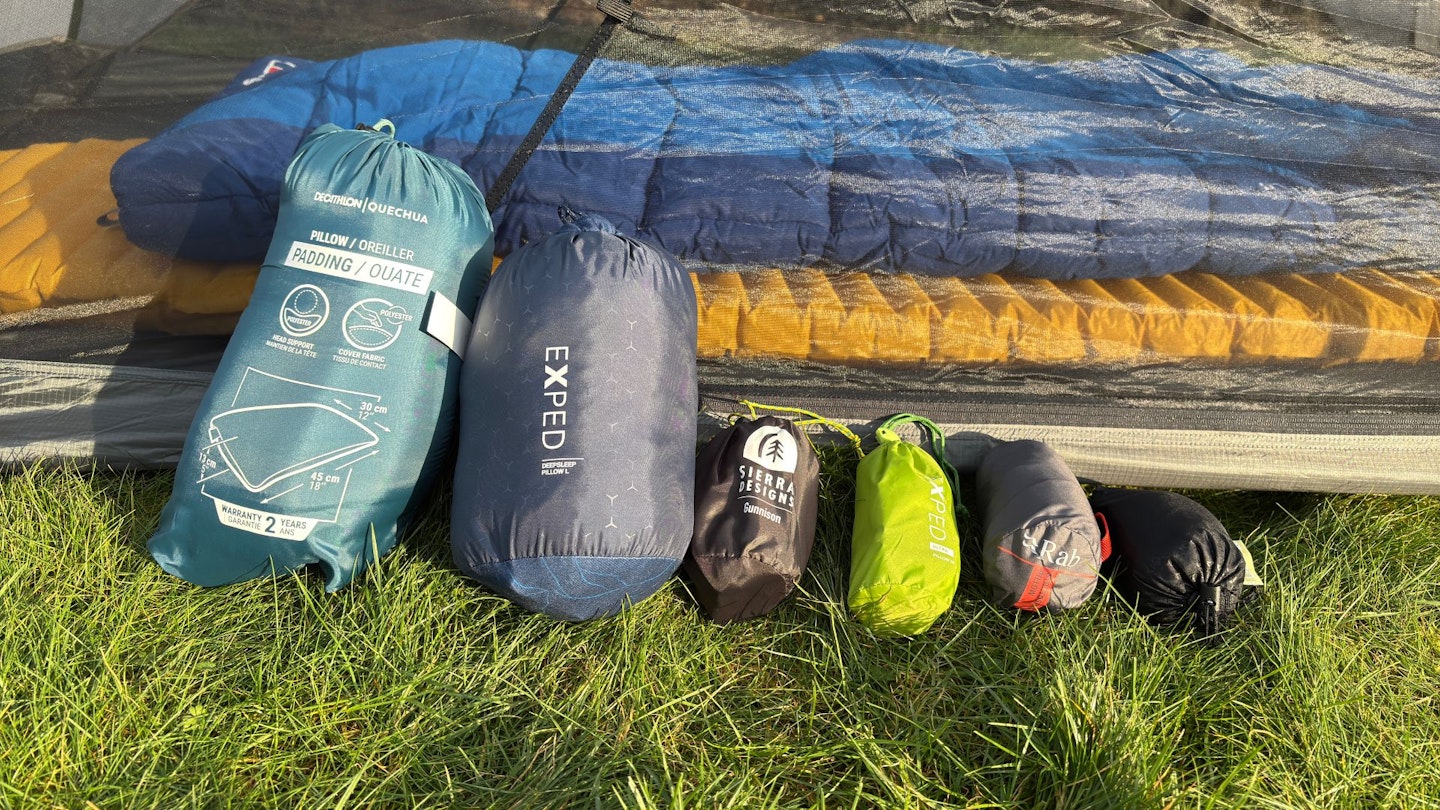
Weight and pack size
How and where you camp has a huge impact on how much the weight and size of your pillow matters.
If you're backpacking you’ll spend more time carrying your pillow than sleeping on it. Therefore, lightness is key, although balancing this with comfort is important.
Plus, a camping pillow is a luxury and you don’t want going into your rucksack at the expense of something more important. Make sure the camping pillow you choose can be accommodated in your pack.
Stuff sacks are very helpful where pack size is concerned, so make sure your pillow of choice comes with one.
Of course, if you're car camping or staying at a base camp, then you can probably afford to give away a little more weight and space, which is when you can opt for slightly plusher pillows.
Comfort and support
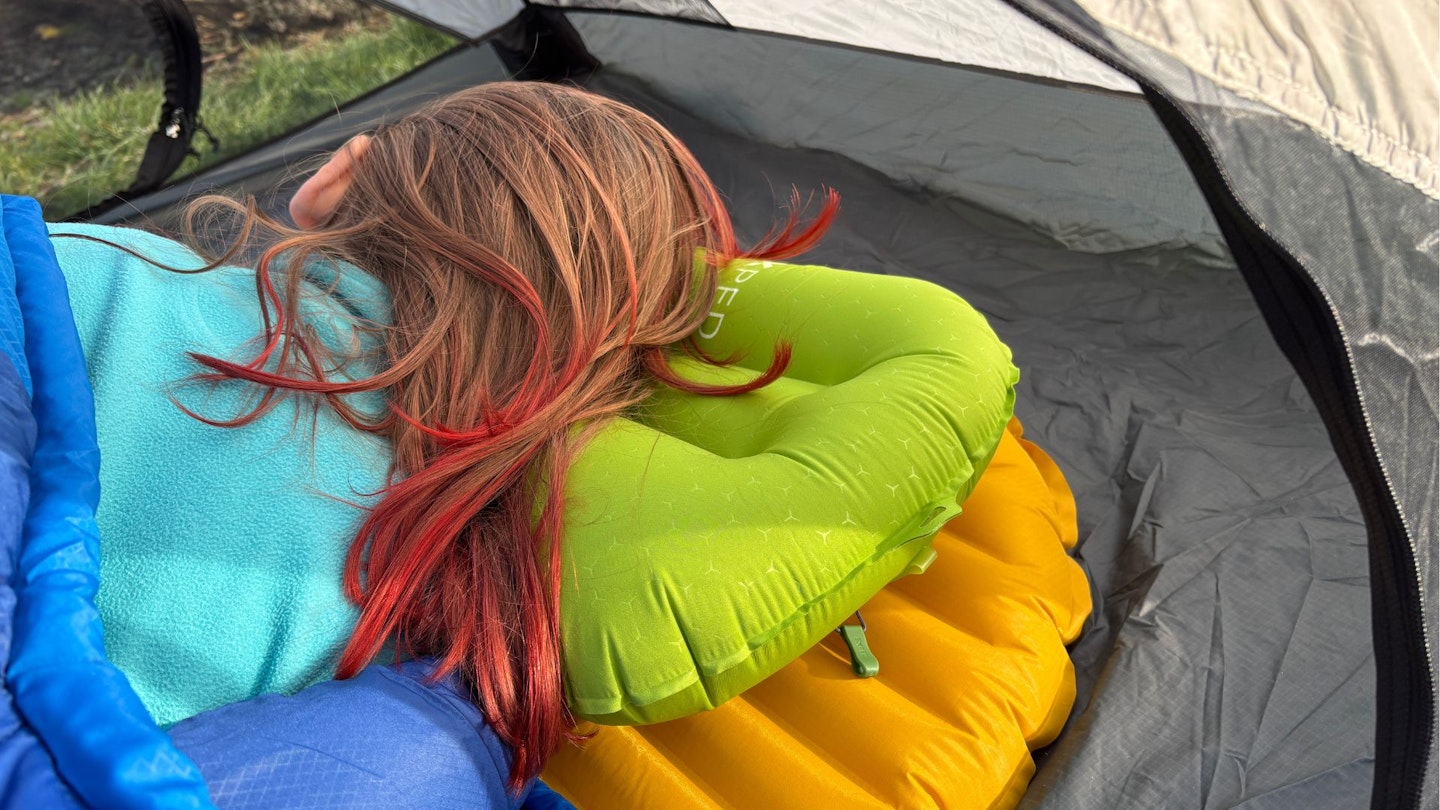
An uber lightweight camping pillow is all well and good, but if you hate sleeping on it then it's still a waste of time. Admittedly, everyone sleeps differently, so think about your personal preferences in line with the following parameters:
Loft (height): Side sleepers often need a thicker pillow to keep their neck aligned, while back and stomach sleepers can get by with flatter, softer options.
Shape: Some camping pillows are contoured to cradle your neck or fit inside sleeping bag hoods. If you're a fidget when you sleep, you might want to opt for a wider choice.
Fabric: As your face will spend hours pressed against your pillow, you need to choose carefully. Consider opting for brushed polyester, microfleece or cotton tops, as they’re softer and less likely to cause irritation than slippery nylon or plastic. If you intend to pop your pillow under your sleeping bag, though, this is less important.
Firmness: Some inflatable and hybrid pillows allow you to fine-tune the height and firmness by adding or releasing air via the valve. That's obviously not possible with foam-stuffed varieties, though fluffing them up after unpacking can restore their shape.
Insulation: Camping pillows sometimes have added insulation. Some people feel the cold more than others and if you’re one of these people, a pillow with some extra insulation might be useful.
Durability and materials
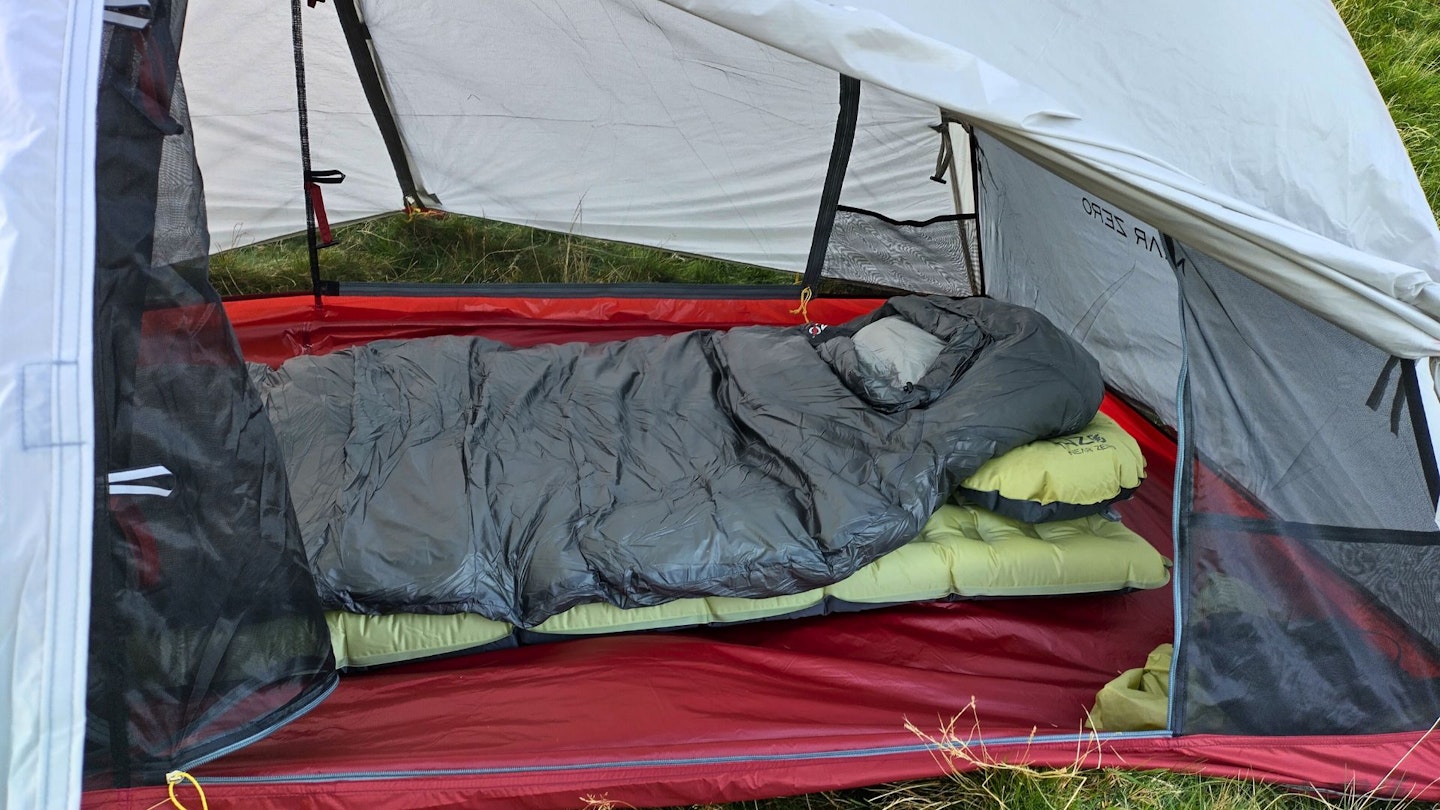
No matter where you're camping, your pillow will be getting pushed, pulled, squished and jabbed over and over again, so it needs to stand up to some abuse.
Abrasion resistant fabrics are key for longevity, so pay attention to the denier (essentially the weight/thickness) of materials. Super lightweight options may be made from 15/20D fabrics, while more robust options may exceed 50D.
Many pillows will be double skinned, with an outer fabric (often softer, for your pleasure) and a more robust inner air bladder.
Polyester, TPU and ripstop nylon are common fabrics to look out for, but also check out the seams to see how strong the sealing or welding looks.
Features
Yes, even a camping pillow can come with multiple features. Ones to look out for are:
Grippy bits: Some pillows have non-slip detailing to keep the pillow from sliding off your sleeping mat.
Two-way valves: A well-designed valve allows you to inflate and deflate to the perfect height and firmness, delivering your ideal level of comfort and support.
Removable covers: Occasionally, you may find a camping pillow that comes with a removable and washable cover. This helps keep your pillow hygienic, especially if you camp a lot.
Stuff sack: If a camping pillow doesn’t come with a stuff sack then we’re disappointed. This should be a basic requirement. Ideally it’s nice and compact yet not so small that it’s a pain to squeeze your pillow into it
Value for money
Like most things, camping pillows can be cheap or expensive. Budget models are often basic, heavier or less durable, but can be perfect for occasional campers or car camping.
Midrange and premium options tend to use lighter, more technical materials, employ clever designs and deliver higher-end fabric for greater comfort and durability.
It’s important to weigh up the price against your expected use. Frequent campers and backpackers will benefit from spending a bit more for a reliable, comfortable pillow.
About the author

LFTO deputy editor Rob Slade has been reviewing outdoor gear for over 10 years, but camping and exploring for much longer. That's included everything from car camping in big tents to wild camping in the UK and overseas.
Chris Williams is an experienced outdoor gear tester who grew up in New Zealand before moving to the UK and spending several years with the LFTO team as a senior writer. Chris loves hiking, backpacking, camping, and pretty much anything that means he can get away from his desk and explore the outdoors.









